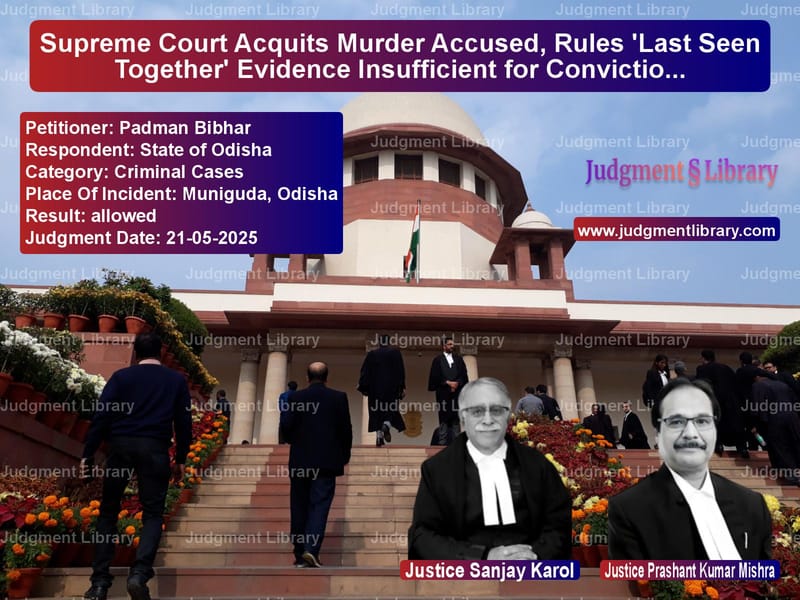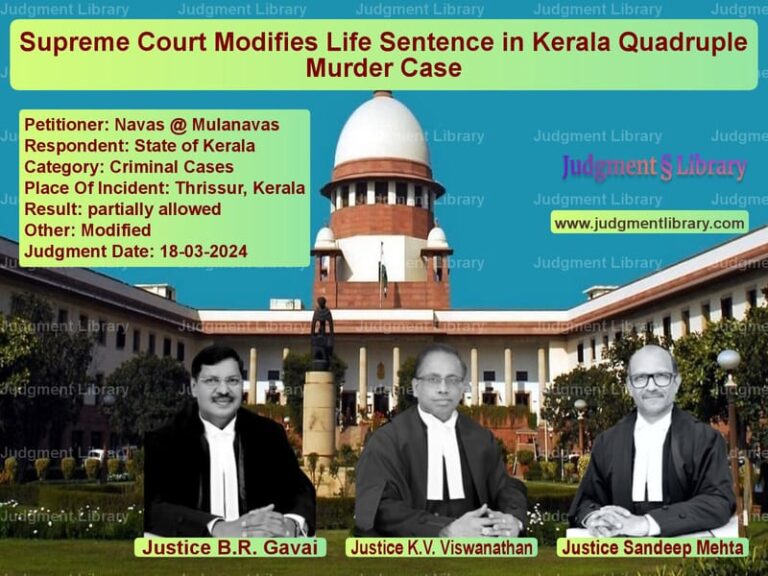Supreme Court Acquits Murder Accused, Rules ‘Last Seen Together’ Evidence Insufficient for Conviction
In a significant judgment that reinforces the fundamental principles of criminal jurisprudence, the Supreme Court has acquitted a man convicted for murder, holding that the evidence of ‘last seen together’ alone cannot form the basis for conviction without additional corroborative evidence. The judgment delivered on May 21, 2025, by a bench comprising Justice Sanjay Karol and Justice Prashant Kumar Mishra, sets aside the concurrent findings of the Trial Court and High Court that had convicted Padman Bibhar for murder under Section 302 IPC.
The case dates back to April 4, 2016, when Akash Garadia, the deceased, went to a river near his village with two friends – Budhadeba Garadia (PW-1) and Susanta Kusulia (PW-2) – for a bath. According to the prosecution, the appellant-accused joined them later and invited the deceased to collect cashew nuts from a nearby field. While PW-1 and PW-2 returned to the village, the appellant and deceased did not return. The next morning, the deceased’s body was found floating in the river, leading to the registration of an FIR against the appellant.
The Prosecution Case and Trial Court Findings
The prosecution built its case primarily on circumstantial evidence, examining 19 witnesses. The Trial Court convicted the appellant under Sections 302 (murder) and 201 (causing disappearance of evidence) of IPC, sentencing him to life imprisonment. This conviction was affirmed by the High Court. Both courts relied heavily on the ‘last seen together’ evidence provided by PW-1 and PW-2, who stated they saw the appellant and deceased going together to collect cashews.
The Trial Court found that “the evidence on ‘last seen together’ and recovery of weapon together with motive are the circumstances which complete the chain of circumstantial evidence and are sufficient to hold the appellant/accused guilty for commission of murder.”
Appellant’s Arguments Before Supreme Court
Mr. Shyam Manohar, learned counsel for the appellant, raised several crucial arguments challenging the conviction. He contended that “there is no direct evidence against the appellant/accused and the chain of circumstantial evidence is incomplete, not connecting him to the crime, therefore, he has wrongly been convicted.”
He further argued that “all the relevant circumstances have not been put to the appellant/accused in his examination under Section 313 Cr.P.C.” and pointed out that “there is a delay of 20 hours in lodging the FIR and the evidence of Chemical Examiner is inconclusive.”
The counsel also highlighted discrepancies in the prosecution case, noting that “there is discrepancy/contradiction about the place where the dead body was recovered inasmuch as at one place it is said to be recovered from a bathing place whereas at a different stage I.O has stated that the dead body was found at the cashew jungle.” He also emphasized that “there is no motive for commission of crime.”
State’s Defense
Mr. Shovan Mishra, learned counsel for the State, defended the convictions, arguing that “the Trial Court and the High Court as well, after careful examination of the evidence, rightly came to the conclusion that the evidence of ‘last seen together’ has been duly proved which along with other incriminating circumstances is sufficient to convict the appellant/accused.”
Supreme Court’s Legal Analysis
The Supreme Court began its analysis by reiterating the settled legal principles governing cases based on circumstantial evidence. The court emphasized that “in a case based on circumstantial evidence, the prosecution is obliged to prove each circumstance, taken cumulatively to form a chain so complete that there is no escape from the conclusion that within all human probabilities, crime was committed by the accused and none else.”
The bench referred to the celebrated judgment in Sharad Birdhichand Sarda vs. State of Maharashtra, which laid down the golden rules for circumstantial evidence cases, requiring that:
“(i) That chain of evidence is complete; (ii) Circumstances relied upon by prosecution should be conclusive in nature; (iii) Fact established should be consistent only with the hypothesis of the guilt of accused; (iv) Circumstances relied upon should only be consistent with the guilt of the accused; (v) Circumstances relied upon should exclude every possible hypothesis except the one to be proved.”
Critical Examination of Evidence
The court conducted a meticulous examination of the witness testimonies. Regarding PW-1 and PW-2’s evidence about being ‘last seen together,’ the court noted significant inconsistencies. While PW-1 stated that when they asked the appellant about the deceased, he kept quiet, PW-2 gave a different version, stating that the appellant told them the deceased had returned before him.
The court observed that “from the above evidence of PW-1, PW-2 and PW-3 it emerges that when they were taking bath, other villagers were there on the bathing ghat, and that the appellant and the deceased had gone to collect the cashew nuts.” Importantly, the court noted that “when the appellant was inquired about the whereabouts of the deceased and he was confronted, he did not admit the guilt rather accompanied PW-3 in search of the deceased near the river and cashew jungle. This conduct of the appellant suggests that he did not run away from the village nor admitted his guilt as probably he had nothing to hide.”
Weakness of ‘Last Seen Together’ Evidence
The Supreme Court extensively discussed the legal position regarding ‘last seen together’ evidence, referring to several precedents. Quoting from Kanhaiya Lal vs. State of Rajasthan, the court emphasized that “The circumstance of last seen together does not by itself and necessarily lead to the inference that it was the accused who committed the crime. There must be something more establishing connectivity between the accused and the crime. Mere non-explanation on the part of the appellant, in our considered opinion, by itself cannot lead to proof of guilt against the appellant.”
The judgment further cited Rambraksh @ Jalim vs. State of Chhattisgarh, which held that “It is trite law that a conviction cannot be recorded against the accused merely on the ground that the accused was last seen with the deceased. In other words, a conviction cannot be based on the only circumstance of last seen together.”
The court elaborated that “Normally, last seen theory comes into play where the time gap, between the point of time when the accused and the deceased were seen last alive and when the deceased is found dead, is so small that possibility of any person other than the accused being the perpetrator of the crime becomes impossible.”
Other Evidentiary Gaps
The court noted several other weaknesses in the prosecution case. The stone allegedly used as the murder weapon was recovered near the dead body but “not in consequence of any memorandum statement of the appellant.” The chemical examination report was inconclusive, and “the blood group was not matched.”
Regarding motive, the court found the prosecution’s theory unconvincing, observing that “if the appellant has any doubt about his wife’s chastity, he would have caused injury or harm to his wife rather than to wife’s cousin with whom he had no animosity.”
The Ultimate Conclusion
After comprehensive analysis, the Supreme Court concluded that “the nature of circumstantial evidence available against the appellant though raises doubt that he may have committed murder but the same is not so conclusive that he can be convicted only on the basis of evidence on ‘last seen together’.”
Quoting from Sujit Biswas vs. State of Assam, the court reinforced the fundamental principle that “Suspicion, however grave it may be, cannot take the place of proof, and there is a large difference between something that ‘may be’ proved, and something that ‘will be proved’. In a criminal trial, suspicion no matter how strong, cannot and must not be permitted to take place of proof.”
The court further elaborated that “The large distance between ‘may be’ true and ‘must be’ true, must be covered by way of clear, cogent and unimpeachable evidence produced by the prosecution, before an accused is condemned as a convict.”
Acquittal and Liberty
In its final ruling, the Supreme Court “set aside the impugned conviction and sentence imposed by the High Court and the Trial Court and acquit the appellant for the charges under Sections 302 and 201 IPC.” The court directed that “The appellant be set at liberty, if he is not required in any other case.”
This judgment serves as a crucial reminder of the high standard of proof required in criminal cases, particularly those based on circumstantial evidence. It reinforces that while ‘last seen together’ can be a relevant circumstance, it cannot alone sustain a conviction for serious offences like murder without additional corroborative evidence that completes the chain of circumstances pointing unequivocally to the guilt of the accused.
Petitioner Name: Padman Bibhar.Respondent Name: State of Odisha.Judgment By: Justice Sanjay Karol, Justice Prashant Kumar Mishra.Place Of Incident: Muniguda, Odisha.Judgment Date: 21-05-2025.Result: allowed.
Don’t miss out on the full details! Download the complete judgment in PDF format below and gain valuable insights instantly!
Download Judgment: padman-bibhar-vs-state-of-odisha-supreme-court-of-india-judgment-dated-21-05-2025.pdf
Directly Download Judgment: Directly download this Judgment
See all petitions in Murder Cases
See all petitions in Bail and Anticipatory Bail
See all petitions in Attempt to Murder Cases
See all petitions in Custodial Deaths and Police Misconduct
See all petitions in Fraud and Forgery
See all petitions in Judgment by Sanjay Karol
See all petitions in Judgment by Prashant Kumar Mishra
See all petitions in allowed
See all petitions in supreme court of India judgments May 2025
See all petitions in 2025 judgments
See all posts in Criminal Cases Category
See all allowed petitions in Criminal Cases Category
See all Dismissed petitions in Criminal Cases Category
See all partially allowed petitions in Criminal Cases Category







